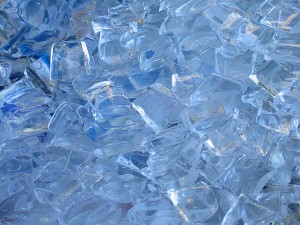Change The Freezing Point of Water

A watched pot never boils, but an electrically charged pot sometimes freezes.
A study in the Feb. 5 Science reports that water can freeze at different temperatures depending on whether the surface it rests on is positively or negatively charged. Under certain conditions, water can even freeze as it heats up.
Source: A charge for freezing water at different temperatures
“We are very, very surprised by this result,†says study coauthor Igor Lubomirsky of the Weizmann Institute of Science in Rehovot, Israel. “It means that by controlling surface charge, either positive or negative, you can either suppress ice formation or enhance ice formation.â€
Water usually begins freezing by forming an ice crystal around a particle of dust or some other impurity. Without that starting point, water can stay liquid well below its freezing point, down to about -42º Celsius. This supercooled water is useful in nature and in the lab, from frogs and fish surviving long winters to cryogenic preservation of blood and tissues.
Scientists have suspected for decades that electric fields could be used to trigger freezing in supercooled water. A molecule of water has a slight positive charge on one end and a negative charge on the other, so electric fields could snap water molecules into a rigid formation by aligning them according to charge.
But previous experiments to understand whether electric fields can influence freezing were complicated by the materials used. The best materials for holding electric charge are metals, but as anyone who has tried to open a car door after a snowstorm knows, ice forms easily on metals even without a charge.
“If you try to do it with metal, you don’t know what is from the electric field and what is from the metal itself,†Lubomirsky says. “We wanted to know whether it is the charge that does it, or something special in metal.â€
Instead of metal, Lubomirsky and his colleagues used a pyroelectric material, which can form a short-lived electric field when heated or cooled. The researchers used four pyroelectric crystals, each of which was placed inside a copper cylinder. The bottom surfaces of two crystals were coated with chromium to conduct an electric charge, and the other two were coated with an aluminum oxide to keep the surface uncharged.
The researchers placed the experimental setup in a humid room and turned down the thermostat until water droplets formed on each crystal, then cooled the room further until the water froze.
With no charge on the surface, the water froze at -12.5º C, on average. But on the positively charged surface, water froze at a relatively balmy -7º. And on a negatively charged surface, ice formed, on average, at a chilly -18º.
“It’s really dramatic, the strong effect of the charge,†says physicist Gene Stanley of Boston University. He also says that the simplicity of the experiment means that “it’s the kind of thing that is almost surely correct.â€
Lubomirsky and colleagues also managed to freeze water by heating it. Water droplets stayed liquid at -11º for up to 10 minutes on a negatively charged surface. But after the negative charge dissipated, heating the room to -8º was enough to induce a positive charge in the pyroelectric crystal and freeze the water.
“That’s a very intriguing behavior,†comments atmospheric physicist Will Cantrell of Michigan Technological University in Houghton. “In this case, on this particular substance, if you warm it up, you can get it to freeze.â€
Coauthor Meir Lahav, also of the Weizmann Institute, says water’s response to charge probably depends on how the water molecules line up against the surface they’re freezing to, though more work is needed to figure out exactly what is happening.
“The water molecules should be aligned differently, so I anticipated that this difference should affect the freezing temperature of ice,†Lahav says. “But I didn’t expect such a large difference. I’m very much delighted to see that.â€
Although he has no specific plans to harness the effect for applications such as cryogenic freezing or cloud seeding, Lahav says his team has already filed a patent.
Ice nucleation, “is a very fundamental problem,†he says. “The moment you understand better — have a new understanding of a new effect — the applications always come afterwards.â€

Leave a Reply
Want to join the discussion?Feel free to contribute!